The view from my bedroom window. When the sun hits it, the whole room takes on a pink hue.
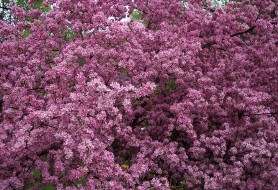

The view from my bedroom window. When the sun hits it, the whole room takes on a pink hue.

The petals from the maple tree blossoms that I posted about yesterday have begun to fall.
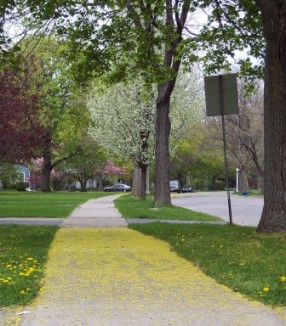
It’s a given that kids love dinosaurs. But there’s another group of critters that have the same kind of appeal — scary, exotic looks, strange names, and you won’t run into them in your back yard.
Deep sea creatures.
Another way they are similar to dinosaurs — and share the same sort of cache — is that we still know so little about their world.
Here’s a BBC article on the results of a recent deep sea trawl that has resulted in the discovery of some new species of fish and other creatures from the watery depths.
Here’s one of my favorite spring-flowering shrubs: Viburnum carlesi, Korean Spice Viburnum. I planted three along the side of my deck a couple of years ago, and every spring since, I’ve been glad I did. Their flowers are wonderfully fragrant — as my daughter said this morning, “that must be what heaven smells like.” And the scent carries. I can smell them everywhere in my yard, and even throughout the house on a warm afternoon when the windows are open.
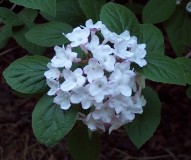
Mine is the compact form so it will only grow to three feet or so. There are other cultivars that will grow to about five feet.
Long before I’d stumbled across my first cultivated Viburnum (in a municipal planting in downtown Rochester, in the evening after work — the lot is now a parking garage) I was familiar with a number of wild species. According to Wikipedia, there are about 175 different shrubs in the Viburnum genus. You may have seen the wild ones, too. They tend to grow in clumps along the margins of forests and fields and bloom with white clusters of flowers. In late summer the bushes are covered with berry-sized clusters of fruit, often blue-black, each with a single flat seed inside. The birds love the fruit, and many are edible for us, too, although they aren’t particularly fleshy or flavorful. Some of the bushes are quite tall, 15 feet or more, and their clumping habit means their canopies form wonderful grott0-like hiding places, perfect for playing when you’re a kid growing up in the country.
My dad once mentioned that his aunt (is that right, Dad?) used to make a jelly from highbush cranberry, one of the wild Viburnums, so I tried it too about 15 years ago. It was an interesting jelly, tart and with a musky, earthy flavor that reminded me of tomato. Kind of. (Here’s a photo of a highbush cranberry bush with fruit. It’s easy to spot since the fruits are a brilliant red.)
Here in New York State, several species of our native Viburnums are sold as ornamentals, but unfortunately some of them are vulnerable to damage (sometimes extensive) by the Viburnum leaf beetle, a pest introduced from Europe. Sigh. Highbush cranberry is one of the species that gets hit the hardest — defoliated, sometimes twice in a year, once the beetles settle in.
I’ve seen the beetle around my neighborhood, so this year I’m going to submit my observations to Cornell to help them track the beetles’ spread. Korean Spice Viburnum isn’t vulnerable, btw. But truthfully, much as I love mine, I’d rather it were vulnerable instead of our native Viburnums. After all, ornamentals, by definition, have humans assigned to their care. Wild plants don’t.
This will give you an idea of the weather we’ve had in my part of the world for the last several days.
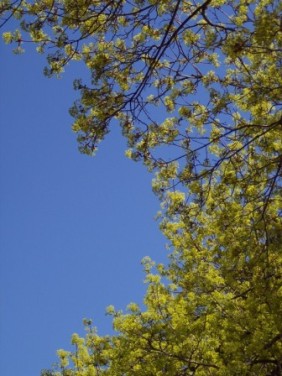
This is also why chartreuse is one of my favorite colors — it’s the color of so many temperate zone tree blossoms (this one’s a maple tree) so around here it’s one of the main colors you see during that first flush of of spring.
Actually, peregrine falcons aren’t only fast for birds. They’re the fastest animal, period. “Scientists have estimated the falcon’s speed to be more than 200 miles per hour.”
A few years ago, it was feared they might go extinct. Now they’re making a comeback, thanks to captive breeding programs.
From a PR standpoint, the birds are also getting a little help from the Internet. “Falcams” — webcams set up so people can watch falcons — are the most popular type of webcam, according to this article by Sandy Bauers in The Philadelphia Inquirer.
Here in Rochester, we have our own falcam: the Kodak Birdcam. Check it out. They’re back.
My dad maintains bluebird houses on his property, so he doesn’t like House Wrens, and I can’t blame him. They’re an aggressive little bird; they’ll go so far as to destroy the eggs of other birds nesting in their territory. Perhaps this is why they are also a successful little bird. According to Cornell University, they have “one of the most extensive ranges of any bird in terms of latitude.”
My suburban home isn’t bluebird habitat, however, so I’m glad to have wrens about. It’s partly nostalgia — wrens used to nest under the eves of the cottage where spent summers with my grandparents, on Cayuga Lake. And it’s partly because hanging a wren box is all but guaranteed to attract a House Wren — they’re so common, and they seem to like being around people. The name “House Wren,” in fact, derives from their tendency to nest near human houses.
So I’ve hung a nest box in the flowering crab apple in the backyard, and every year a pair settles in to raise a family.
I heard one sing for the first time this year, a couple of days ago, and managed to get a photo of him yesterday.
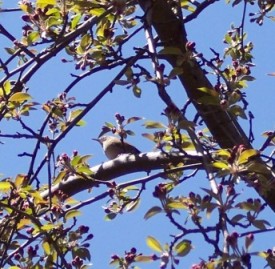
The best way to identify wrens (other than their song, which I’ll get to in a sec) is their profile, particularly their tail, which they carry pointed upward at a feisty angle. Their plumage, otoh, is an unremarkable, dull brown, making the females a stand-in for modesty, as in the verse “When Jenny Wren Was Young” from The Real Mother Goose:
‘Twas once upon a time, when Jenny Wren was young,
So daintily she danced and so prettily she sung,
Robin Redbreast lost his heart, for he was a gallant bird.
So he doffed his hat to Jenny Wren, requesting to be heard.“Oh, dearest Jenny Wren, if you will but be mine,
You shall feed on cherry pie and drink new currant wine,
I’ll dress you like a goldfinch or any peacock gay,
So, dearest Jen, if you’ll be mine, let us appoint the day.”Jenny blushed behind her fan and thus declared her mind:
“Since, dearest Bob, I love you well, I’ll take your offer kind.
Cherry pie is very nice and so is currant wine,
But I must wear my plain brown gown and never go too fine.”
Perhaps Jenny Wren’s suitability as wife to the more stylish English Robin is related to her royal lineage: the wren is considered King of the Birds. It’s a title won by trickery, however. When the birds decided the one who could fly the highest would be their king, the wren hid itself in the feathers of an Eagle. The Eagle flew as high as it could, and then the well-rested wren emerged and flew yet higher, winning the crown.
A darker bit of Old World folklore is the hunting of the wren:
Down to the present time the ‘hunting of the wren’ still takes place in parts of Leinster and Connaught (in Ireland). On Christmas Day or St Stephen’s Day the boys hunt and kill the wren, fasten it to the middle of a mass of holly and ivy on the top of a broomstick, and on St Stephen’s Day (26 December) go about with it from house to house, singing: “The wren, the wren, the king of all birds,/St Stephen’s Day was caught in the furze;/Although he is little, his family’s great,/I pray you, good landlady, give us a treat.” Money or food (bread, butter, eggs, etc.) were given them, upon which they feasted in the evening’ (Golden Bough, 1 vol. ed. Macmillan, 1963 (originally 1922), pp. 536-7). – In England such rituals died out in the nineteenth century, but the song survived.
The origins of the ritual aren’t clear — Wikipedia mentions a tradition that Saint Stephen was betrayed by a wren, but the scholarship in the piece linked above suggests it predates Christianity.
Here in North America, the wren’s significance is considerably more prosaic: when the wrens have returned, you know it’s truly spring.
You can’t miss a wren’s song, either. It’s distinctive (my grandfather called it a “bubble de bubble”) and delightful, and also loud — Native Americans called the House Wren “o-du-na-mis-sug-ud-da-we-shi, (making a big noise for its size)” (although apparently it plays second fiddle to its close relative, the Winter Wren, which has the distinction of a song with “10 times more power than a crowing rooster” ).
Yep, you can’t miss them.
And now they’re back. There’s still time, too, if you want to enjoy wrens around your house this year. You can find wren houses in hardware and big box building supply chains — they’re the small, cheap ones ;-)
Meanwhile, here’s a Cornell web page where you can get info on house wrens, including a wav file of its song so you can hear that bubble de bubble for yourself.
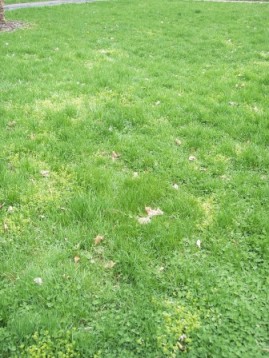
Actually there are a handful — you may be able to make them out toward the top of the photo.
But. There are far fewer than there were last year, which is a reason to celebrate, because this marks the one-year anniversary of my starting a program of organic broadleaf control.
My secret weapon is corn gluten, a byproduct of cornstarch production that acts as a natural pre-emergent herbicide — it inhibits root growth of newly sprouted seeds. (It’s also a 10-0-0 slow release fertilizer.) (I buy it at Bristol’s farm market in Victor.)
In addition to the corn gluten, I set my mower blades pretty high (three inches). The idea is that taller grass is healthier grass — the root system becomes stronger — and healthier grass is able to crowd out other plants. Taller grass also helps the earth retain moisture and prevents light from reaching any weed seeds, which prevents them from germinating. It looks okay, too — when it’s freshly cut it’s nice and neat; you can’t really tell it’s being cut longer unless you walk across it. (Don’t use the photo as the guide on that point — I haven’t mowed yet, this spring.) And it doesn’t mean I have to cut more often, either — leaving it longer doesn’t make it grow faster.
My lawn is a perfect lab for this experiment, since my property’s previous owner never did anything but mow, and until last year, I didn’t either. So that was 15, maybe 20 years of laissez-faire lawn care, plenty of time to establish a nice colony of broadleaf plants: ground ivy, white clover, violets, broad leaf plaintain, speedwell, dandelion, purslane, wild lettuce, dock.
In the photo, you can see clover in the foreground. The lighter-color patches are speedwell, probably slender speedwell, Veronica filiformis. It’s a low-growing plant that tends to spread out in mats. It is more noticeable now than it will be later, because it’s in its first flush of spring growth. Plus the patches are smaller this year than before.
Which means next year they’ll be smaller yet. Or who knows? Gone completely. We”ll see.
What I’m doing, at this point, is waiting out the perennials. Dandelions, for instance, can live five years or so. I have to wait until the established plants have passed on before my lawn will be pretty much dandelion-free.
Speedwell is a nice little plant, actually, with pretty, delicate little flowers. I also like dandelions. But I’m proving a point to anyone in my neighborhood (or elsewhere, for that matter) who thinks they need to hire chemical companies to spray horrible-smelling, toxic, expensive chemicals on their grass.
Corn gluten isn’t outrageously expensive, either. A $30 bag is plenty to treat my front yard. (I don’t bother with the back yard.) I’ve only treated it in the spring although I’ve read somewhere that a second, late summer application is helpful since some weeds germinate in the fall.
You’ll pay more to have an organic lawn care company care for your lawn than a conventional lawn care company, of course.
But if you’re willing to spread the stuff yourself, it’s not a budget-breaker.
Here’s an Organic Gardening magazine article on organic lawn care.
Here’s another, although this one kind of plays up the expense and difficulty. It’s not that complicated, really. I suppose some lawns might be more trouble, if the soil was deficient in specific nutrients or something. But in my case, if I decided to do more, like spread compost, it would be just for the sake of puttering, not because the lawn really seems to need it.
I’ll post another pic after I mow.
Update: and then came the compost …
Here’s an interesting article in New Scientist about an emerging subspecialty in behaviorism/evolutionary biology: how animals adapt when they move into urban areas.
I blogged about urban coyotes here, with a link to an article that briefly discusses how coyote behavior is different in urban environments than rural ones.
It’s an area that will yield a lot of surprising insights in the future, I predict.
Here’s an interesting piece in The Chronicle Review by anthropologist Donna Hart, who surveys the evidence and makes the claim that early man was mostly prey, not predator. She writes:
Large-scale, systematic hunting of big herbivores for meat may not have occurred any earlier than 60,000 years ago — over six million years after the first hominids evolved.
Meanwhile, we were being hunted by a variety of toothy critters.
My study of predation found that 178 species of predatory animals included primates in their diets. The predators ranged from tiny but fierce birds to 500-pound crocodiles, with a little of almost everything in between: tigers, lions, leopards, jaguars, jackals, hyenas, genets, civets, mongooses, Komodo dragons, pythons, eagles, hawks, owls, and even toucans.
Toucans. Our ancestors were eaten by toucans. I’ll never look at Froot Loops the same way again . . .